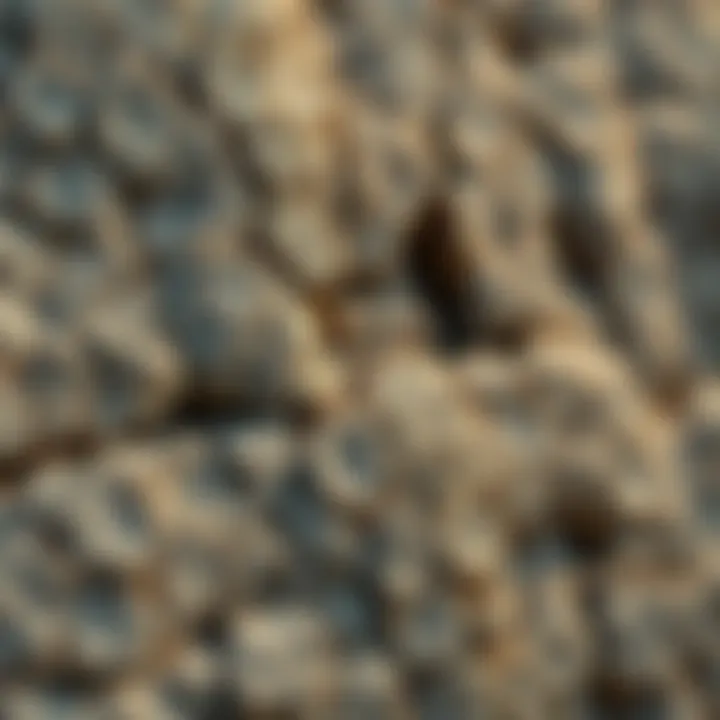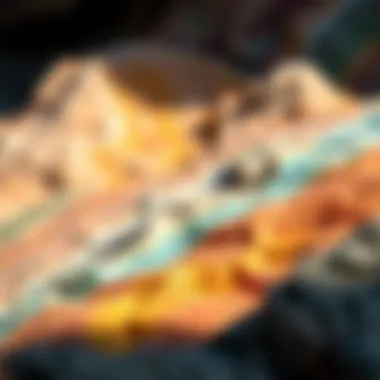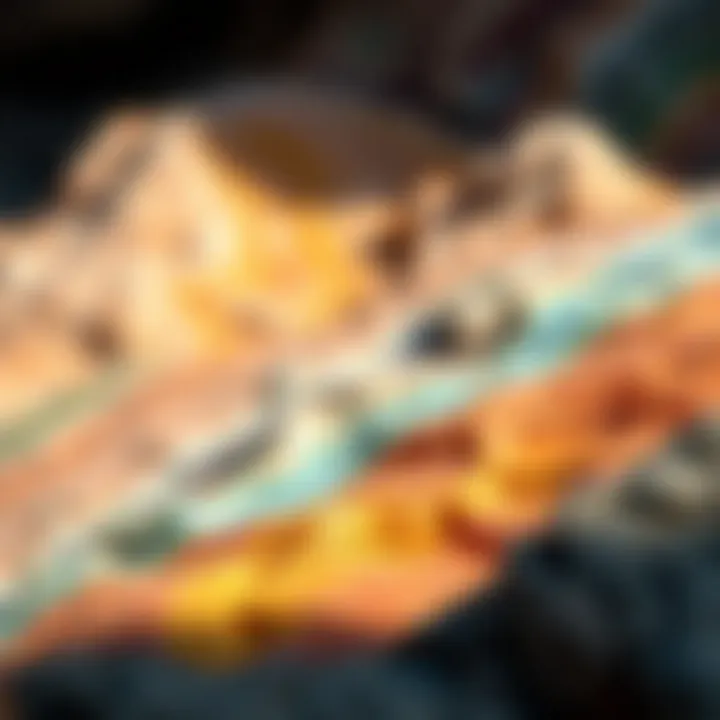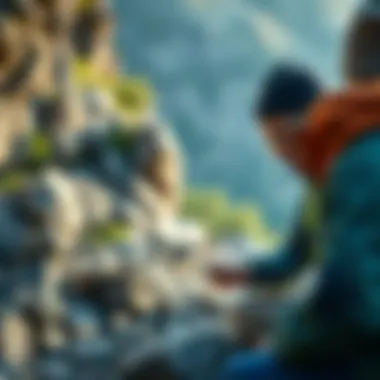Capturing the Beauty of Rocks Through Photography


Intro
Photography and geology may seem like distant worlds, yet they intertwine beautifully when it comes to exploring rocks and their stories. This journey into the realm of images captures not just the surface of these geological marvels, but their underlying essence and significance. As we venture into this article, we will perceive rocks not just as simple minerals or collectibles, but as a vivid tapestry woven from the fabric of our planet’s history.
History and Origins
Photography’s role in geology dates back to the rise of the medium itself. The first photographs of rocks and fossils made significant inroads in the 19th century, introducing a new dimension to geological science. The intersection of art and science paved the way for collectors and researchers to document and share their findings visually.
Overview of Collectibles, Rocks, and Fossils
Rock and fossil collecting has been a cherished hobby for centuries. Individuals scour the earth for beautiful specimens, ranging from glittering quartz to delicate trilobites. These collectibles allow for a tangible connection to the past, representing millions of years of geological processes. Enthusiasts appreciate the uniqueness of each piece, while the photographic representation serves to immortalize them beyond their physical existence.
When seen through a lens, rocks shift from mere objects to captivating stories frozen in time. Collectors often gather to showcase their discoveries, creating a community bound by a shared fascination with nature’s artistry.
Historical Significance and Cultural Impact
Throughout history, cultures have imbued rocks with cultural and spiritual significance. Many indigenous societies believe certain stones harbor powers or wisdom. For instance, the vibrant colors of a geode go beyond their aesthetic appeal; they symbolize balance and harmony in some traditional practices. Artists, too, have drawn inspiration from the forms and patterns found in mineral formations. Landscapes decorated with geological wonders impress and inspire, serving as eye-catching subjects for photographers looking to depict nature's artistry.
“A photograph isn’t just a picture; it’s a window into history, holding the memory of times that once were.”
Understanding the historical context provides depth to the appreciation of rocks. It is vital for collectors to grasp how these stunning natural artifacts fit into the grand narrative of earth’s evolution.
Identification and Classification
Identifying and classifying rocks is an essential skill for any collector. The nuances of different rock types offer rich avenues for exploration and pride in one’s collection.
Guide to Identifying Rocks and Fossils
To excel in identification, one must consider several features:
- Texture: Is the rock smooth, rough, or layered? This impacts its classification.
- Color: Variations can indicate different minerals present within the rock.
- Weight: Heft can often provide clues regarding rock composition.
- Location: Knowing where the rock was found can hint at its geological origin.
Each identifier opens up a treasure trove of information, enhancing the collector's journey. Techniques for documenting these characteristics through photography are vital, ensuring that the beauty and uniqueness of each piece are preserved.
Common Types and Variations
The world of rocks is filled with fascinating varieties, including but not limited to:
- Igneous Rocks: Formed from cooled magma or lava, such as basalt and granite.
- Sedimentary Rocks: Created from the accumulation of sediment, examples include sandstone and limestone.
- Metamorphic Rocks: Altered by heat, pressure, and chemical processes, such as marble and schist.
Every category holds a plethora of variations, offering collectors numerous angles for exploration and enrichment. Those keen on photography can leverage these differences to create striking visual narratives, bringing attention to the unique characteristics of each rock type.
Preface to the Importance of Visual Media in Geology
When we think about geology, often the mind wanders to vast landscapes and deep caverns, but what about the intricate details captured in the photographs of the rocks that make it all possible? Visual media plays a pivotal role in understanding geology, especially for rock and fossil collectors. In its simplest form, a photograph can reveal the very essence of a rock's characteristics, from its texture to its color, serving as a bridge between scientific inquiry and personal appreciation.
The benefits of visual media in geology are manifold. First, images communicate information that words often fail to express. For instance, consider a speckled granite versus a smooth basalt. Looking at a photograph can enhance one’s comprehension of these rock types significantly better than mere descriptions. Images also offer a universal language—for collectors and enthusiasts who may speak different languages or come from different backgrounds. A remarkable photograph of a unique mineral formation can spark interest across borders, urging people to explore geology through a shared passion.
Moreover, in the realm of education, visuals can enhance learning. Students of geology often find themselves navigating through various rock types and minerals. Visual aids like photographs can clarify complex concepts and processes, making it easier for them to grasp the material. Take a layered sedimentary rock, for example. A clear image showcasing the various strata can exemplify the processes of deposition better than any lecture could.
Besides their educational prowess, images have practical implications too. They serve as a record for collectors. Every photograph collected can document personal finds, helping to categorize samples and track changes over time. This cataloging serves not just personal, but also scientific purposes. When collectors share their images online or in publications, they contribute to a larger pool of knowledge about geological specimens.
In essence, visual media—particularly photography—shapes how we capture, share, and understand geological specimens. The interplay between image and geology makes the study not only about the rocks themselves but also about the narratives they tell us. Whether for educational purposes, personal collections, or sheer aesthetic appreciation, the visual representation of geology remains a foundational pillar in this captivating field.
The Role of Images in Understanding Geology
Images breathe life into geology. They allow for a firsthand experience—even if indirectly—of the intricate details entrenched within each rock. Observe a photograph of a pumice stone with its airy bubbles: this simple image encapsulates the concept of volcanic rock formation that might take considerable effort to describe in text.
A well-captured image can make even the most mundane stones fascinating. Key features like colors, textures, and imperfections present in a photograph can lead to deeper inquiry. Colors can indicate mineral content; a photo showcasing the iridescence of an opal engages the eye, prompting further research into its formation and properties.
Images also facilitate collaborative endeavors. Enthusiasts and professional geologists can compare visual data across platforms, thus broadening the collective understanding of geological specimens. Furthermore, as social media plays an increasing role in how we disseminate information, platforms like Instagram and Reddit create spaces for unique shares among passionate communities. Remarkable images can encourage dialogue among various individuals, thus enriching everyone's knowledge.


How Photography Enhances Collecting Experiences
Photography in the field can dramatically enhance the experience of collecting rocks. For a collector, each rock or mineral tells its own story, and documenting these through images is akin to preserving a moment in time. Photos transform experience into memory, turning a simple field trip into a personalized geological journey.
When collectors examine their finds, they often want to remember not just the rocks but the experience itself. A photograph capturing the backdrop of the location—perhaps a striking mountain range or an expansive beach—can evoke feelings of adventure and curiosity that will remain long after the rock has been safely tucked away.
Additionally, as collectors share their images on digital platforms, they open themselves to feedback from peers. A well-timed shot of a rare specimen might draw attention from experienced collectors or even geologists, leading to meaningful conversations and potentially valuable lessons. Throughout these exchanged visuals, collectors not only add value to their own collections but also contribute to a communal cache of knowledge around geological diversity.
Through photography, rock collecting becomes more than just gathering stones; it evolves into a rich tapestry woven with experience, understanding, and connectivity—qualities that resonate deeply within the geology community.
Types of Rocks and Their Visual Characteristics
Understanding the visual characteristics of different rock types is vital for anyone involved in geology or rock collecting. Each rock type—igneous, sedimentary, and metamorphic—comes with its distinct features that can tell a story about its formation, composition, and even the environment it came from. This section delves into how these visual traits can be documented through photography, enhancing the appreciation of these natural wonders.
Igneous Rocks: Capturing Their Unique Textures
Igneous rocks, formed from cooled magma or lava, possess a diverse range of textures that photographers must capture effectively to communicate their unique properties. For example, basalt, with its fine-grained texture, contrasts sharply with the coarse grains found in granite. Often, the fine surface of these rocks holds intricate details that invite a closer look. To best showcase these aspects, the angle of light is crucial. Natural sunlight can highlight these textures, revealing the flow patterns and crystal structures within the rock.
When photographing igneous rocks, consider using a macro lens to zoom in on the details that regular lenses might miss. This approach allows the photographer to focus on individual minerals or pits that are characteristic of certain igneous formations. The play of light on these surfaces can create dramatic images that not only attract attention but also better communicate the geological processes at work.
Sedimentary Rocks: Visualizing Layers and Fossils
Sedimentary rocks are the storytellers of the geological world. They often present layers, each formed over time, encapsulating evidence of past environments, like riverbeds or ancient oceans. Their visual characteristics, notably the striations and fossil imprints, are of great significance in photography.
In capturing sedimentary rocks, it’s key to focus on these layers. A horizontal shot can illustrate stratification, telling viewers about the historical processes that led to the formation of the rock. Additionally, shots that include fossils can reveal the biological history of the area. For instance, a close-up of a fossil embedded in sandstone not only emphasizes its detail but also connects viewers with Earth's prehistoric life.
"The beauty of sedimentary rocks lies in their layered history, waiting to be explored through the lens of curious eyes."
Metamorphic Rocks: Highlighting Transformative Features
Metamorphic rocks undergo significant transformation due to heat and pressure, which are visually apparent in their foliated or non-foliated textures. Take schist, for example, known for its shiny, foliation that is often accentuated by light. Capturing this shiny surface can add depth and dimension, illustrating the metamorphic processes that give the rock its unique appearance.
Photographers can employ various strategies to highlight these transformative features. Using side lighting can enhance the contrast within the rock’s texture, making those shimmering layers pop. It’s essential to experiment with different angles to find the one that best showcases these qualities. Properly done, metamorphic rock photography can transform mere rocks into vibrant narratives of Earth’s geological history, inviting viewers to appreciate the forces that crafted such beauty.
Techniques for Photographing Rocks
Photography can be an alluring gateway to understanding geology. Well-captured images of rocks do more than just reflect their physical attributes; they tell stories. This is why mastering the techniques for photographing rocks becomes a valuable asset for both enthusiasts and professionals in the field. The right approach not only enhances the visual appeal of your photographs but also ensures that every shot conveys the unique characteristics of the geological specimen. With various techniques at your disposal, you elevate not just your images but also the educational and aesthetic value they provide.
Choosing the Right Equipment for Rock Photography
To adequately capture the nuances of rocks, investing in the correct equipment is paramount. The right tools can make a world of difference, transforming a good image into an exceptional one. While professional gear may often be expensive, it's not always necessary to break the bank.
- Camera: For those serious about rock photography, a DSLR or mirrorless camera is a wise choice, as they offer superior image quality. However, even a high-quality smartphone can suffice for everyday photography. The key is understanding your camera's settings.
- Lenses: A macro lens is ideal if you want to emphasize the intricate details of the rocks, like the crystals in igneous rocks or the layers of sediment found in sedimentary rocks. Conversely, a wider lens can be great for large formations.
- Tripod: Stabilizing your camera helps prevent blurriness, especially in low-light situations or when you're capturing those detailed close-ups.
These elements combined make up the foundational building blocks of great rock photography. Crafting visual stories about rocks begins with the right gear in your hands.
Lighting Considerations for Optimal Images
Nothing alters an image more than lighting. Natural light can either elevate your photographs or lead to disaster. Understanding how to harness and manipulate light is vital to achieving stunning images.
- Golden Hour: The hour just after sunrise or just before sunset provides soft lighting that enhances textures without harsh shadows. This time of day breathes warmth into your images, giving rocks an inviting glow.
- Cloudy Days: Overcast conditions are favorable, as the diffuse light minimizes shadows and renders colors evenly. This is perfect for capturing the true hues of your rocks without the interference of glaring light.
- Flash and Reflectors: When in shadowy environments like caves, or during the late evening, using a flash or light reflectors can help to illuminate the subject. Just be mindful to keep reflections natural; no one wants overly glossy or artificial-looking shots.
These considerations can take your photographs from ordinary to extraordinary, ensuring that they do justice to the beauty and complexity of geological specimens.
Composing Rock Photographs: Essential Tips
Once you’ve set up your equipment and mastered lighting techniques, it's time to think about composition. A well-composed photograph can tell a thousand tales, while a poorly composed shot might miss the mark completely.
- Rule of Thirds: Imagine breaking your image into three parts horizontally and vertically. Positioning your rock off-center can create a more engaging composition.
- Foreground Interest: Including elements in the foreground, such as pebbles or plants, can provide depth to your images. This additional layer encourages viewers to visually explore your photograph.
- Textures and Patterns: Capturing the textures of the rock can draw viewers in. Zoom in on the crystalline structures, or the swirling patterns found in metamorphic rocks. Don't hesitate to get creative with angles—sometimes, a shot from below can yield captivating results.
"The beauty of rocks lies not just in their colors but often in their textures and layers. Photography brings these elements to life, showcasing their intricate stories."


As you refine these techniques, keep in mind that practice makes perfect. The more you experiment with different compositions and settings, the more adept you will become at capturing the evocative world of rocks.
For more resources and detailed discussions on rock photography, you might find the following websites helpful:
- Wikipedia – Geology
- Britannica – Rock
- Reddit – Photography
- Facebook – Rock Collectors
- Geological Society
With these insights into equipment, lighting, and composition, you're now prepared to embark on a journey into photographing rocks, bringing their unique beauty to the fore.
Ethical Considerations in Rock Photography
When diving into the vibrant world of rock photography, it’s not just about capturing stunning images. The ethical aspects are pivotal to ensure that the beauty of the earth is not only represented accurately but also preserved for future generations. Missteps in this realm can have significant consequences, from harming ecosystems to misrepresenting geological data. Therefore, understanding and addressing ethical considerations becomes essential for every rock and fossil collector or photographer.
Respecting Natural Habitats
The first question that springs to mind is: how does one respect the natural environments where these rocks exist? Rock photographers must recognize that many geological sites are more than just picturesque locations; they are delicate ecosystems that support a range of flora and fauna. By trampling over sensitive areas, a photographer might inadvertently destroy fragile habitats. For instance, stepping on moss or rare plant life while setting up for the perfect shot can disrupt the local ecology, which may take years or even decades to recover.
For responsible photography, it’s wise to ask:
- Are you sticking to marked paths? Keep to established walking trails to minimize impact.
- Have you checked for regulations? Many parks and nature reserves have strict rules regarding geological sampling and photography.
“Take only pictures, leave only footprints,” is a wise guideline that resonates deeply in this context.
Additionally, utilizing tools like drone photography comes with its own set of ethical demands. Drones can disturb wildlife, especially during breeding seasons, and it’s crucial to research and follow guidelines concerning their use in natural habitats. Ultimately, a little consideration goes a long way in ensuring that the natural beauty we wish to capture remains untouched.
Avoiding Misrepresentation of Geological Samples
Ethics in rock photography also extends to how these geological samples are represented. Misleading images can result in the spread of false information, which undermines both scientific research and public understanding. For rock and fossil collectors, presenting the conditions of your finds accurately is crucial. A stunning close-up photo of a mineral could mislead viewers if it doesn't reflect the true conditions under which it was found.
Consider these points to avoid misrepresentation:
- Provide context in your shots. Capture the rock in its natural setting; this helps depict its true characteristics.
- Be honest about post-editing. While some enhancement is common—think color correction—it’s essential to maintain the integrity of the original geological features.
- Educate your audience. Share information about the rock, like its formation process or what makes it unique. This adds depth to your photography and promotes a better understanding.
Applications of Rock Photography
Rock photography has a vast array of applications that resonate deeply within multiple fields such as education, science, and art. By capturing the intricate details of rocks, both amateurs and professionals can utilize these images for various purposes beyond mere record-keeping. Understanding the significance of rock photography sheds light on how images can enhance our connection to geology, making it an invaluable resource for enthusiasts like rock and fossil collectors.
In educational contexts, photographs serve as a bridge between theory and practice. High-quality images can bring the geological world to life for students and educators alike. They facilitate discussions in classrooms, allowing for clearer visualizations of complex concepts, such as stratification or mineral composition. Additionally, well-captured rock images can ignite curiosity among learners, encouraging further exploration into the planet’s history and processes. A picture may truly be worth a thousand words in this case, as it simplifies the learning experience while enriching it simultaneously.
Educational Uses: Enhancing Learning and Understanding
Using rock photography in education can take various shapes. Here are a few key considerations:
- Visual Aids: Rock images can be utilized in textbooks, online courses, and presentations, allowing students to recognize different rock types and their textures. This common visual language aids retention of information.
- Field Studies: Bringing images from actual locations into the classroom prepares students for fieldwork. When they can see first-hand what to expect, they approach investigations with a more informed mindset.
- Engaging Content: Engaging students through visual storytelling captivates attention and fosters an environment where inquiry thrives.
Ultimately, when photographs illustrate geological phenomena, they create a sense of place and time that enriches the educational process.
Scientific Documentation: Cataloging Geological Research
In the realm of scientific inquiry, rock photography offers a reliable method for documenting geological samples and findings. Researchers often rely on visuals to substantiate their work. Here’s how such documentation thrives:
- Evidence: High-resolution images can support research findings or hypothesis claims, allowing geologists to present clear visual evidence in their papers.
- Comparative Analysis: By maintaining a comprehensive visual record, scientists can compare specimens over time, observing changes that might inform broader geological theories.
- Open Access: As science leans increasingly towards transparency, sharing rock images on platforms like ResearchGate or academia.edu makes valuable data accessible to global audiences.
Photographs thus serve not just as decorative assets; they act as crucial touchstones of dependable evidence necessary for scholarly pursuits.
Aesthetic Appreciation: The Art of Rocks
Beyond the scientific narrative lies the undeniable aesthetic charm of rocks captured through a lens. Each geological specimen tells a story not just of age, but of beauty and natural marvels. The artistic dimension in rock photography can be explored through:
- Composition: Expertly shot images highlight textures, lighting, and colors that can redefine how we perceive these natural materials. By playing with angles and contrasts, photographers reveal striking details that might otherwise escape a casual observer.
- Emotional Resonance: Just like artistic landscapes, rock photography can evoke a sense of wonder. A rugged cliff face or colorful mineral formation can resonate emotionally, leaving observers with lingering thoughts about time and nature.
- Cultural Reflections: Different cultures appreciate rocks in varied ways, and photography can explore these interpretations, showcasing how diverse communities connect with their geological environments.
“Art is the most beautiful of all lies.” — Pablo Picasso


Rocks, through photography, exemplify the marriage of nature and art, reminding us to appreciate the geological wonders that surround us while exploring the narratives they weave through our history.
In summary, the applications of rock photography facilitate not only scientific rigor, but also aesthetic appreciation and educational advancements. Whether one is a collector, educator, or a casual enthusiast, the visual medium proves essential in deepening our understanding and appreciation of geology.
Showcasing Rock Photography
Rock photography holds a unique place in the crossroads of art and science. It encapsulates the aesthetics of natural formations while serving critical functions in geological study. When done right, rock photography showcases the beauty of geological specimens, inviting viewers to appreciate the often overlooked intricacies of these natural wonders. Furthermore, it helps convey vital information to both enthusiasts and professionals alike about the unique characteristics of rocks.
High-quality images can truly convey the essence of a specimen. They can highlight the unique textures, colors, and patterns that are characteristic of different rock types. In a world saturated with information, powerful visuals become essential tools in teaching, documenting, and celebrating geology.
"A single photograph can capture what words often fail to convey the story of time etched in stone."
When showcasing rock photography, it’s not just about snapping a picture. There's an art to it, which involves going beyond the surface and understanding the geological narratives behind each rock. Understanding lighting, composition, and the setting can drastically elevate the visual appeal.
Creating a Portfolio: Best Practices
Building a portfolio is a substantial step for any budding or established rock photographer. It serves as a personal gallery that speaks to an individual's style, technique, and perspective. Here are some best practices to consider when creating a compelling portfolio:
- Diversity in Subject Matter: Include a range of rock types, geological settings, and photographic styles. This showcases versatility, ensuring that viewers get a comprehensive view of your ability.
- Quality Over Quantity: Choose your best work. A few stunning images are worth more than a hundred mediocre ones. A portfolio should reflect precision and intent.
- Consistency in Presentation: Use a similar editing style or color palette across images to create a unified look. This helps form an identity in your photography.
- Descriptive Captions: Adding context to your images enhances understanding. Brief descriptions outlining the geological significance or the photographic challenge can add depth to your portfolio.
- Update Regularly: Just like the ever-changing landscape of geology, your portfolio should evolve. Regular updates keep your work fresh and relevant.
By adhering to these best practices, a rock photography portfolio can effectively capture the nuances and beauty of geological formations, making it a gateway for potential clients or audiences to engage with your artistic vision.
Sharing on Digital Platforms: Methods and Strategies
In today’s digital age, having a solid online presence is crucial for any photographer. Sharing your work boosts visibility, facilitates networking, and connects you with like-minded individuals. Here are some effective methods and strategies for showcasing rock photography on digital platforms:
- Social Media Optimization: Platforms like Instagram and Pinterest thrive on visual content. Use these to your advantage by presenting your photography through appropriate hashtags such as #RockPhotography, #GeologyLovers, or #NaturePhotography.
- Create a Dedicated Website: Having a personal website not only serves as a portfolio but also as a blog where you can delve into your thoughts on rock photography, techniques used, rock types, and your exploration journeys. This can establish your authority in the field.
- Engagement with Community: Participate in forums or groups on Reddit or Facebook, where enthusiasts share their work and seek feedback. Engaging with the community fosters relationships and opens potential collaboration doors.
- Utilize SEO Techniques: Ensure your online posts are SEO-friendly. This includes using strategic keywords related to rock photography, geology, and relevant hashtags to improve search engine visibility.
- Feedback and Adaptation: Don’t be afraid to solicit feedback on your work from fellow enthusiasts. Constructive criticism can refine your skills and enhance your portfolio.
By employing these methods and strategies, the exposure gained can lead to valuable opportunities in both artistic and professional realms within rock photography.
Future Trends in Rock Photography
The realm of rock photography is steadily evolving, keeping pace with advancements in technology and shifting cultural narratives. Understanding future trends offers invaluable insights into how collectors and enthusiasts can enhance their photographic practices and appreciation of geology. The fusion of new methods and fresh artistic perspectives propels this field forward. As technology advances, the potential for innovative techniques and broader accessibility grows, presenting both opportunities and challenges for rock photography enthusiasts.
The Impact of Technology on Geological Imaging
Technology stands as a key player in reshaping geological imaging. With the advent of sophisticated cameras, drones, and software, capturing the intricate beauty of rocks has never been easier or more interesting. For example, high-resolution cameras not only deliver stunning detail but also facilitate post-processing options that were previously unimaginable.
- Drones: The use of drones for aerial photography has opened up new vantage points. This aerial perspective allows photographers to capture geological formations from unique angles, showcasing vast landscapes that ground-level shots might miss.
- 3D Imaging: The future of rock photography isn’t limited to two-dimensional images. With 3D imaging technologies, it becomes possible to create dynamic representations of rock formations. These interactive models can enhance educational purposes, enabling a more profound understanding of geological structures.
- Software Enhancements: Applications that utilize machine learning can help identify and categorize rock types automatically. As these systems improve, rock collectors can spend more time appreciating the beauty and less time on technicalities.
With each advancement, we face considerations. Photographers must navigate the ethical landscape of technology use in natural environments. It’s easy to get swept up in the excitement of new technology, but one must remember that respect for nature is paramount.
Emerging Artists and New Perspectives
As rock photography evolves, so does the pool of artists contributing to its rich tapestry. Emerging photographers bring fresh perspectives, often reflecting their unique experiences and backgrounds. This infusion of creativity can push traditional boundaries and introduce groundbreaking styles.
A few trends among emerging artists include:
- Experimental Approaches: Many up-and-coming photographers are experimenting with abstract representations of rocks. By focusing on color, texture, and form rather than the rocks' scientific characteristics, they’re creating a new way to appreciate geological specimens. This can invite a more emotional connection with the subject matter, making rocks seem alive.
- Cultural Narratives: Some artists are incorporating cultural narratives into their work. They highlight the relationship between rocks and local histories, bringing geological wonders into a broader context that underscores humanity's interaction with earth materials.
- Social Media Influence: The rise of platforms like Instagram has provided aspiring photographers a space to share their work widely. With hashtags connecting different communities, the exposure leads to collaborations that might not have occurred otherwise, further enriching the field.
These emerging voices reflect a dynamic landscape, challenging established norms and urging collectors and enthusiasts to see rocks—and the stories they carry—from new angles. The future is bright with potential, as the convergence of technology and creativity continues to evolve the art and science of rock photography.
Finale: The Enduring Significance of Rock Photography
As we part ways with the myriad insights shared throughout this exploration, it becomes evident that rock photography is not just an artistic endeavor; it is a significant pillar in the realms of geology, education, and aesthetics. The marriage of photography and geology enriches our understanding of nature, allowing us to capture and preserve the intricate details of rocks in a way that words often fail to convey. Rock photography holds a mirror to the Earth’s history, showcasing not only the textures and colors associated with different rock types but also the stories encapsulated within them.
Specific Elements and Benefits
- Visual Communication: The fusion of visual imagery with geological studies breaks down complex concepts into easily digestible formats, making it relatable even for those less versed in geology.
- Encouraging Exploration: A captivating photograph can ignite curiosity, prompting viewers to engage in fieldwork or rock collection themselves. It serves as an invitation into a world that, while often overlooked, is teeming with beauty and scientific marvels.
- Cross-Disciplinary Dialogue: Rock photography crosses boundaries between science, art, and education, creating a conversation that involves a broader community. This dialog enhances collaborative learning experiences especially in academic settings, where visuals can help convey scientific principles effectively.
In light of these benefits, photographers specializing in rock photography play a crucial role in documenting geological diversity, inspiring others to ponder the interconnectedness of life and Earth’s processes. However, it is important to traverse this field with an ethical lens, ensuring respect for natural habitats and the accurate representation of geological samples.
Reflecting on the Aesthetic and Scientific Value
The aesthetic quality found in rock photographs can awaken an appreciation for the natural world. Each image tells a unique story, capturing the light filtering through quartzite or the striations in schist, often leaving viewers in quiet awe. More than mere pictures, these photographs preserve a snapshot of time, freezing geological processes that may span millions of years.
"Art is the most beautiful of all lies, and science is the most truthful of all stories." This encapsulates how rock photography straddles both realms, offering insights that resonate with different audiences.
Moreover, the scientific value of these creations cannot be overlooked. They deliver critical documentation for geological research, education, and public awareness. From illustration of morphological geology to the promotion of conservation efforts, rock photographs fuel scientific exploration and engagement in geology.



